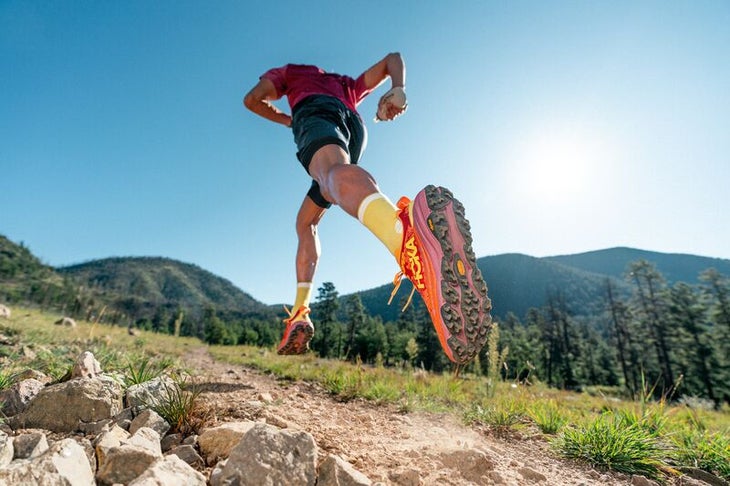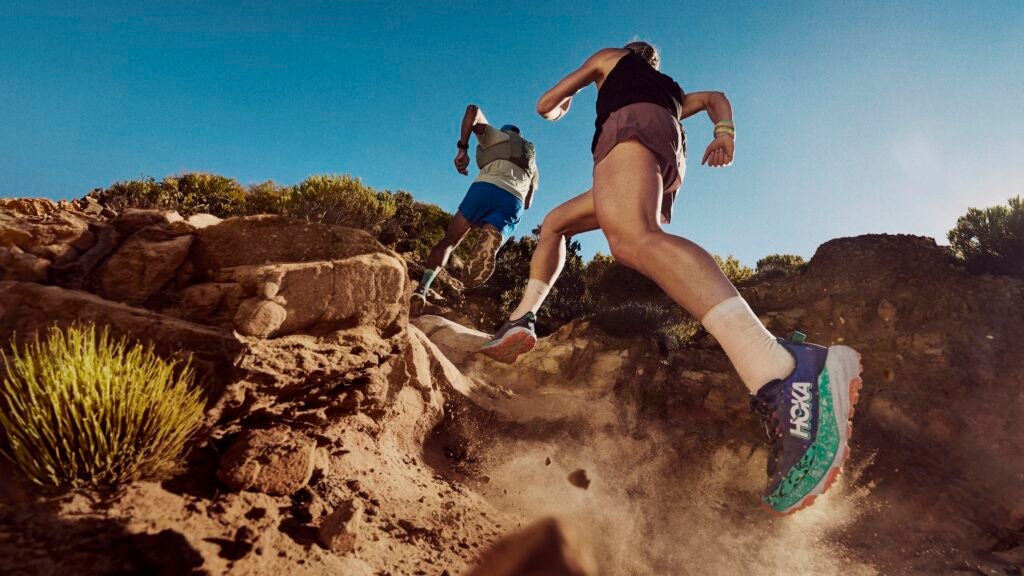No products in the cart.
Outdoor Adventure
Is This Running Challenge Ridiculously Hard, Ridiculously Fun, or Both?
Here’s your summer challenge: log 11,000 feet of elevation in 30 days. Work your way up—walking, running, or hiking—and track your cumulative vertical gain in Strava’s HOKA Be the GOAT Challenge to complete those 11,000 feet. Sound absurd? That depends on your perspective.
From the streets of Manhattan, you’d need to scale the Empire State Building steps nine times to log 11,000 feet. From the edge of the Grand Canyon, you’d still need to climb 1,000 feet after doing a round-trip from rim to rim to rim. From Mount Everest Base Camp, 11,000 feet of elevation gets you right below the highest summit in the world.

From your nearest favorite trailhead, 11,000 feet is the right goal if you want to extend your trail running abilities to new heights. That total is just shy of what competitors climb during the Wasatch Mountains UTMB Speedgoat 50K race. (There, runners climb 11,318 feet over 31 gnarly miles.) It’s also attainable when you factor 30 days with the work and family needs of daily life that conspire to keep you from biting off big distances and vertical gains in such epic-sized chunks.
Wherever you live, you can find terrain that burns your glutes, quads, calves, and lungs—even if you live in the flatlands, where a climb means heading to stadium stairs at the local high school. Wherever you find your vertical, it’s worth it, because the feeling you get from answering that challenge is hard to match.
Take it from Sage Canaday, a professional ultrarunner and coach who’s won the famed Pikes Peak Ascent and UTMB Speedgoat 50K: “Literally running up a mountain is empowering,” Canaday says. “It builds mental toughness and creates confidence.”

Plus, the physical benefits are hard to deny. Running uphill, Canaday notes, can create a great training dynamic where you have less impact force with each step, but you can learn to generate more power with each stride. Not only that, Canaday adds, “It’s an awesome way to challenge the heart and lungs with minimal impact.”
If you want even more rewards, finish Strava’s HOKA Be the GOAT Challenge (live from July 15 to August 15), and you’ll earn a Speedgoat 6 digital badge and a special gift mailed directly from Hoka. If you go big and log the most overall elevation gain over the challenge’s 30 days, you’ll claim a year’s supply (12 pairs!) of Hoka trail running shoes, a trophy to commemorate your victory, plus a free entry to any one of the following U.S. 2025 UTMB events: Speedgoat, Grindstone, Kodiak, Desert RATS, and Canyons.
And if you live in San Francisco, Salt Lake City, Boulder, Colorado, or Charlotte, North Carolina, you can level up the fitness test—and your prize chances—with Strava’s HOKA Be the GOAT Challenge. Take on your local running community by completing the most reps of your local hill climb over 30 days. The men’s and women’s entrants who log the most reps on that climb also win entry into a 2025 U.S. UTMB race of their choice.
Live elsewhere? What’s the tallest climb in your area? Have you run or hiked it? Probably not as much as possible within a 30-day period. This challenge is your summer call to elevate.
Up and Away: Claim Some Serious Vert at the Steepest, Most Destination-Worthy Routes for Incline Training
Cactus to Clouds Trail, aka Skyline Route—Palm Springs, CA
20.3 miles; 10,715 feet total elevation gain
Plan accordingly for extreme temperature swings on this leg-burning point-to-point from the desert floor to alpine wilderness.

Manitou Incline—Manitou Springs, CO
1-mile climb (4 miles round-trip); 2,000 feet total elevation gain
This is a direct staircase climb (loop back from top via the three-mile Barr Trail descent) that’s popular among locals and visitors. Reservations are required.
Adirondacks High Peaks Circuit—Newcomb, NY
Mileage and total elevation gain varies depending on mountain(s) climbed.
Of the 46 Adirondack High Peaks (above 4,000 feet), only about half have designated trails. The highest peak, Mount Marcy (5,344 feet), offers 3,166 feet of elevation gain over 14.8 miles.

Mahoosuc Traverse—Andover, ME
30.4 miles; 10,577 feet total elevation gain
Due to giant boulders that require scrambling over and squeezing between, this point-to-point is known as the hardest single mile on the Appalachian Trail.
Slickrock Creek Trail—Robbinsville, NC
12.1 miles; 4,337 feet total elevation gain
Numerous stream crossings help cool off hikers along the steep and taxing wilderness out-and-back that locals lovingly refer to as “the Ballbuster.”
Mount Shasta, Avalanche Gulch Route—Mount Shasta, CA
10.1 miles; 7,217 feet total elevation gain
Though it’s a technical out-and-back that requires an ice axe, crampons, helmet, and skills (guide recommended), this route caters to beginner mountaineers seeking the 14,180-foot summit of this volcanic icon.
______________________________________________________________________
HOKA® is one of the fastest-growing performance footwear and apparel brands in history. Conceived in the mountains, HOKA footwear delivers an unprecedented combination of enhanced cushioning and support for a uniquely smooth ride. Every day, HOKA pushes the innovation and design of its footwear and apparel by teaming up with a deep roster of world champions, tastemakers, and everyday athletes. From finish lines to everyday life, HOKA fans love the brand for its bold and unexpected approach and its belief in the power of humanity to create change for a better world. HOKA empowers a world of athletes to fly over the earth. For more information, visit HOKA.com or follow @HOKA. #FlyHumanFly

